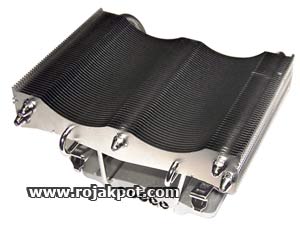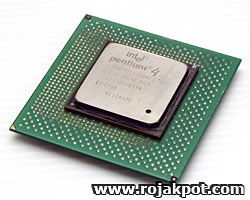How Is Overclocking Possible?
Some people think that overclocking isn't possible. Why? Because if a processor can run at a higher clock speed, they would have sold it at that speed. After all, the cost of a processor increases with its clock speed rating.
However, computer chips aren't actually graded and sold according to the maximum speed at which they can safely run. No doubt chip makers would love to do that, but practicality and market forces dictate otherwise.
Speed Binning
This 1.7GHz Pentium 4 processor came off the same line as its 1.6GHz and 1.8GHz brethren. |
All processors start out from the same line. Unlike what some may think, chip makers do not have dedicated lines for processors of different speed grades. Instead, they have a single line from which all processors of the same model are made. Even then, these chips will not turn out exactly the same.
At the end of the fabrication process, some chips will invariably be non-functioning or malfunctioning. Those that work though will not have the same characteristics. Some will be able to run faster while others can only run at a lower clock speed. However, it would take an extraordinarily long time to test each and every chip and discover their maximum potential.
To save time, chip makers use a method called "speed-binning". Instead of testing and selling chips at their maximum clock speed, they test and sell chips at certain speed grades - like 1GHz, 1.2GHz, etc. This is one of the reasons why overclocking is possible.
Suppose a chip maker sells a particular processor at 3 different speed grades - 1GHz, 1.2GHz and 1.4GHz. After every processor is made, it is first tested at 1.4GHz. If it passes, then it's labelled and sold as a 1.4GHz processor. If it fails at that clock speed, it's retested at 1.2GHz and labelled as a 1.2GHz processor if it passes. Otherwise, it's tested at 1GHz. If the processor fails at that speed, then it's discarded.
But no matter what clock speed a processors is rated at, some potential remains hidden thanks to speed-binning. For example, a processor may be speed-binned at 1.2GHz, but if you actually test its limits, it may run at 1.33GHz. That's one reason why overclocking is possible.
Market Considerations
In a perfect world, chip makers would first test each chip at the highest speed grade and work their way down until the chip passes the test. However, market forces often intervene and prevent them from doing so.
Even if a chip is capable of running at a very high clock speed, consumers may prefer a lower-speed grade. As such, demand for a lower-speed grade may far exceed the chip maker's production of slower-running chips. In such an event, chip makers often have to relabel faster chips and sell them as lower-speed chips. In other words, chip makers often grade chips according to market demand.
For example, a chip maker may be able to make a processor that runs at 2GHz about 90% of the time. However, only 10% of the market are demanding for that speed grade while 40% want a slightly slower 1.8GHz speed grade and the remaining 50% want the slowest 1.6GHz speed grade.
So, the chip maker will have no choice but to filter out and sell only 10% of their chips at 2GHz. Even though most of their remaining chips can potentially run at 2GHz, they will test and sell them at the slower speed grades.
This is another reason why overclocking is possible. Many chips out there are not running at their maximum potential. This is especially true for lower-speed grades of long-established chip production lines. The fabrication process may have been refined enough to produce many high-speed chips but market demand may force the chip maker to sell them at lower-speed grades.
Safety Margin
Like many things that we buy, computer chips are covered by warranty against malfunction during normal use. However, their behaviour is affected by different environmental conditions. For example, the hotter the ambient temperature, the higher the likelihood of a chip failing at a particular clock speed.
To pad against environmental variables like ambient temperature, chip makers add some margin to a processor's speed grade. For example, if they successfully certify that a processor can run at 1.4GHz, they will label and sell it as a 1.2GHz. The 200MHz margin is their way of ensuring that the processor will run properly even in a different environment from that of the test lab.
This margin is another reason why overclockability is not only possible, but a certainty with every chip. It's only a matter of how much a chip can be overclocked.
Heat
 |
A popular heatsink used by overclockers - the Thermalright SI-120 |
Chips produce heat. All else being equal, the higher the clock speed, the greater their thermal output. Unfortunately, the tremendous output of heat reduces a chip's ability to run at higher clock speeds. That's why processors often have active coolers which serve to whisk away heat from the processor.
The cooler's ability to remove heat from the processor is affected by ambient temperature. A processor that runs well at an ambient temperature of 25°C may not even boot up when used in an ambient temperature of 30°C.
Generally, a processor will be able to run faster in a cooler environment, especially if it has a good active cooler. That's why overclockers have tried using water and even liquid nitrogen to cool down the processor and allow it to run at much higher clock speeds.
This relationship with heat is also a reason why overclocking is possible. By reducing the thermal load of a processor, we can improve its ability to run at higher clock speeds. A cooler environment almost automatically improves the overclockability of a chip.
<<< Newbie's Guide To Overclocking, Why Overclock?, What's A MHz Or GHz? : Previous Page | Next Page : Which Type Of Overclocker Are You?, What Does A System Consists Of?, Know Your System >>>







 Add to Reddit
Add to Reddit

